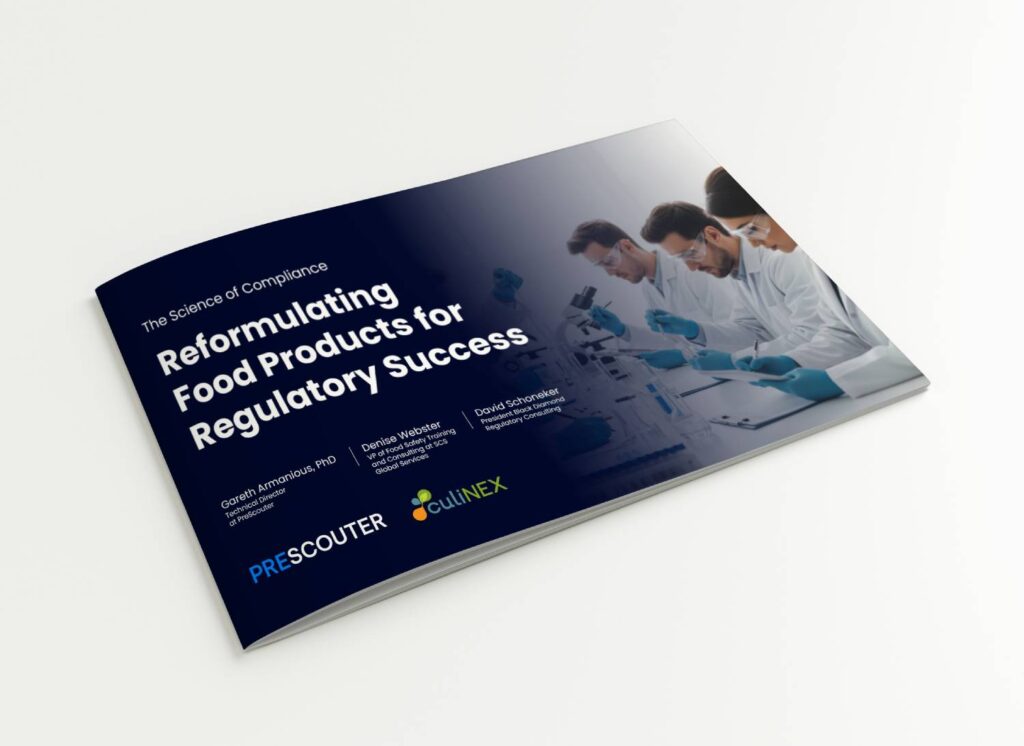Food companies today face growing pressure from regulations, consumer expectations, and misinformation when planning reformulations. Each decision now carries financial and reputational stakes, where delays can lead to costly rework or compliance failures. That’s why the most effective teams bring R&D, regulatory, operations, and marketing together early to avoid missteps and protect launch timelines.
The triggers behind reformulation decisions:
Government bans and ingredient restrictions often leave food manufacturers with little choice but to reformulate. The EU’s ban on titanium dioxide is a clear example, where legal mandates overruled ongoing scientific debate. Despite regulators in the U.S., Canada, and Australia maintaining it as safe, companies must comply when the law demands action.
These inconsistencies across regions push multinational brands to constantly adjust their formulations to meet local rules. A product considered compliant in one country may trigger reformulation elsewhere, increasing cost and complexity. In practice, legal directives frequently outweigh scientific consensus, forcing teams to act faster than research can evolve.
Misinformation and public pressure
Viral misinformation has become one of the strongest forces shaping food reformulation today. Influencers and online headlines can ignite consumer fear faster than scientific consensus can respond. When public opinion shifts this rapidly, even safe products face reformulation pressure simply to protect brand credibility and maintain consumer confidence.
A clear example comes from Subway’s removal of azodicarbonamide after it was branded the “yoga mat chemical.” General Mills faced a similar situation when it replaced artificial colors in Trix to match the “natural” trend, only to face consumer backlash and revert. These reactions show how misinformation and emotion can erode trust, leading companies to spend millions to fix issues created more by perception than fact.
Internal marketing pressures
Marketing teams often push for ingredient changes to match current consumer trends, even before full validation. These moves can seem exciting at first, promising “cleaner” labels or natural appeal. Yet, rushing reformulation this way often leads to unstable products, labeling errors, or safety oversights that could have been avoided with proper coordination.
Such decisions usually come from pressure to maintain a competitive edge or refresh brand image. When done without proper regulatory review or sensory testing, they can damage consumer trust instead of strengthening it. Balancing marketing goals with scientific due diligence keeps reformulation grounded, ensuring products stay compliant, safe, and true to their intended quality.
Navigating the misinformation engine:
Social and political narratives often exaggerate chemical hazards, turning minor concerns into industry-wide panic. Headlines about ingredients being “banned in Europe” usually stem from political debates rather than scientific consensus. When this happens, brands rush into reformulation decisions that add unnecessary costs and confuse consumers who trust regulatory bodies to act on solid evidence.
A good example comes from California’s Prop 65 lawsuits, where courts blocked warnings based on unsettled science. Such cases show how overstated risks can mislead shoppers and pressure companies into defensive changes. Overreactions like these waste resources, create fear-driven markets, and distract teams from addressing genuine safety priorities.
Strategic response framework
When misinformation spreads faster than science, reacting too quickly can magnify confusion and cost. Food companies need structured, disciplined responses that balance legal accuracy, consumer trust, and operational stability.
Here are some simple steps that keep decisions fact-based, legally sound, and aligned with brand trust:
- Build evidence: Start by gathering credible data that reflects scientific consensus and aligns with current regulatory findings. Summarize studies, expert opinions, and prior rulings to anchor your position before decisions escalate.
- Run legal review: Engage legal experts to review claims, ensuring they don’t exaggerate hazards or imply false risks. This step protects the company from misleading label changes or regulatory overreach driven by public sentiment.
- Educate carefully: Communicate transparently about ingredient trade-offs, stability, and performance without amplifying fear. The goal is to help consumers understand complex science in relatable terms while maintaining brand confidence.
- Act with discipline: Reformulate only when laws change or when customers genuinely demand an alternative. Acting with restraint avoids wasteful reactions and preserves credibility across regulatory and consumer channels.
Foresight and monitoring: Anticipating change
Building early-warning systems helps companies stay alert to subtle regulatory movements before they become mandates. Teams should continuously monitor proposals, petitions, and agency updates from organizations such as the FDA and EFSA to anticipate potential changes.
In parallel, sentiment scanning across news, forums, and social platforms offers real-time context for shifting opinions. By connecting these signals with expert analysis, brands can tell the difference between passing trends and meaningful risks.
Predicting regulatory flashpoints
Colorants remain one of the most sensitive categories, with pressure growing toward “natural” and “exempt” alternatives. These replacements often face challenges in consistency, stability, and scalability, making early testing and supply checks essential for long-term success.
Sweeteners and ultra-processed ingredients are drawing renewed scrutiny as definitions evolve and labeling rules tighten. At the same time, sustainability-driven innovations like cultivated or precision-fermented components raise new questions around safety pathways and consumer perception.
Future-proofing the portfolio
Future-proofing reformulation means planning beyond immediate headlines and focusing on long-term regulatory stability. Teams should map ingredients under scrutiny, study policy patterns, and invest in replacements built for durability, not short-term wins.
Selecting substitutes that can withstand shifts in policy and perception helps minimize repeated reformulations. By pre-qualifying alternative ingredients and confirming scalable supply, companies maintain consistency, protect margins, and ensure compliance remains ahead of disruption.
Operational and compliance risk management:
Reformulation should be managed like any controlled process, with clear checkpoints and defined accountability. Teams that rush without these controls often face labeling errors, allergen issues, or failed audits, which could have been avoided through early coordination.
Success depends on bringing every department, QA, food safety, labeling, and packaging, into the conversation from the start. When these teams work together early, they prevent last-minute confusion, protect compliance, and keep reformulation timelines steady.
Safety and quality Risks
Substituting synthetic ingredients with natural ones can alter a product’s chemistry, texture, and stability. These changes influence how colorants interact with light, heat, and pH, often leading to shorter shelf life and inconsistent sensory quality.
Natural replacements introduce variability because their impurity profiles differ by supplier, season, and origin. Limited supply and higher production costs, sometimes five to ten times more than synthetics, further complicate consistent performance and price stability.
Labeling and claim validation
Labels and claims are critical for maintaining consumer safety and brand credibility, making accuracy non-negotiable. Even minor errors, such as missing allergens or misaligned claims, can trigger costly recalls and erode trust.
Early hazard analysis verifies that formulation changes meet all safety and labeling requirements before launch. Integrating validation steps into every project stage keeps nutrition data and claims consistent while preventing compliance gaps.
Balancing compliance and consumer acceptance
Maintaining consumer trust while meeting compliance demands requires anticipating reactions with scientific and labeling accuracy. Brands must track allergens, nutritional variations, and sensory changes to ensure reformulations don’t compromise safety or consumer confidence.
Changes work best when introduced gradually and backed by consistent data validation across every stage. Communicating transparently, especially about flavor or sodium adjustments, helps consumers adapt naturally and keeps regulatory trust intact.
Strategy and competitive advantage:
Good governance strengthens a company’s resilience by ensuring every reformulation decision is grounded in foresight and preparation. When teams consistently review ingredient risks and maintain scenario plans, they prevent emergencies and sustain profit margins through stable product lifecycles.
It’s practical to ask, “If this ingredient were banned tomorrow, what’s our backup?” because such thinking builds operational confidence and financial security. Keeping global product claims consistent further reduces compliance costs and allows brands to scale without repeated reformulations.
Enabling small teams for big compliance
Small teams can handle regulatory demands with structure rather than size. Building a trusted circle of advisors, consultants, and peers ensures expertise is always within reach. Regularly reviewing new FDA or regional updates prevents surprises and turns compliance into an ongoing conversation rather than a scramble.
Keeping a standing core team, covering food safety, quality, packaging, and labeling, creates stability across every change. This small yet steady group reviews reformulations end to end, ensuring no gaps appear between technical and commercial priorities.
Science, marketing, and consumer reality
Managing science and perception has become a defining challenge for modern food manufacturers. Brands must weigh credible toxicology data against changing consumer expectations while maintaining product consistency. Acting on incomplete information can erode trust, but evidence-based decisions backed by sound science strengthen long-term credibility.
Some leading companies have found success by combining scientific grounding with consumer choice. Mars, for instance, kept synthetic options while introducing “natural” alternatives, giving customers flexibility without disrupting production lines. General Mills followed a similar strategy after restoring its original Trix formula, proving that informed flexibility sustains both trust and integrity.
Future-proof your reformulation strategy:
As ingredient scrutiny intensifies and regulations grow more complex, success now depends on disciplined, data-driven reformulation strategies that anticipate change rather than react to it.
That’s where PreScouter comes in – helping R&D and regulatory teams design science-backed reformulations that meet compliance standards, protect brand credibility, and stay ready for the next wave of legislation.
Here are some of the challenges we’re helping to solve:
- How can food companies anticipate the next ingredient ban before it disrupts formulations?
- How is AI transforming labeling compliance and claim validation workflows?
- How can regulatory teams counter misinformation before it drives unnecessary reformulations?
- What exactly qualifies as “natural,” and how are regulators redefining clean-label claims?
- How will growing regulatory divergence by 2030 impact global product strategy and compliance planning?
- How are leading CPGs using digital compliance dashboards to monitor reformulation and labeling risks in real time?
Connect with PreScouter’s experts and future-proof your reformulation roadmap.








